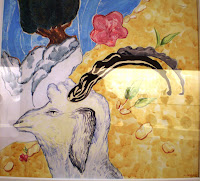
Glorious Beasts in Persian Painting, Museum of Fine Arts, Boston, MA. An exhibition at the MFA by Boston-based artist Conley Harris.
According to the introductory labels, artist Conley Harris’s interest in the subject stems from his fascination with Indian and Persian miniatures, where since 2003 he began incorporating Indian and Islamic influences into his work. By further reading the labels, the viewer understands that the exhibition displays new works by the artist that are supposed to “engage in dialogue” with the Persian miniatures in the MFA’s collection.
Harris’s paintings are fanciful scenes that are altered versions of the MFA miniatures. He creates a fusion between the historic miniatures and his new paintings by producing mostly enlarged interpretations, thereby creating new works that are “rhapsodic” in their own right, even when not compared to their MFA counterparts, a rather interesting approach. The paintings are displayed side by side with their MFA inspirations in an effort to create a contrast; Shepherd’s Pet by Harris was inspired by A Goatherd (1675), a Safavid period miniature. A Hunting Scene from Safavid Iran( 2nd half of the 16th century), a gold and opaque watercolor on paper, became an inspiration for High-Spirited Horseman. Assuming that the viewer is willing to read the labels by each painting, they describe the artist’s intent and the visual relationship between the original miniature and the newly created artwork.
When questioning the curatorial or design aspects of the exhibition in which the paintings are displayed, it is important to understand that the MFA in Boston is an example of a museum whose small but impressive Islamic Art collection has hardly changed over the years. The collection is confined to a corridor that leads to other galleries making it hard for the average viewer to stop and appreciate the artifacts. An exhibition in which such magnificent artworks are to be displayed, should be executed in a way that facilitates the “visual interpretation” of the work. Its layout should enable the viewer to understand the complexity of the theme without relying on lengthy labels. In the case of Glorious Beasts, the effect achieved by the synthesis of old and new which is the main theme, is evidently lost to the viewer. Unless one is willing to read all four or so introductory panels, and all smaller labels accompanying each artwork, the whole idea can seem utterly obscure.
Unfortunately for Glorious Beasts, the location (corridor), coupled with the choice of miniatures displayed, has neither helped the exhibition get its point across, nor has it succeed in highlighting the MFA’s collection. The contrast that Harris has tried to attain in his paintings was overshadowed by the exhibit itself, it was perhaps clear only to those seeking it, but will be completely lost to those who will pass by the Islamic Art Corridor on their way to perhaps more “exciting” parts of the museum.
In the end, I am not so glad I went to see… Glorious Beasts in Persian Painting
A Goatherd, Iran, Safavid Period, 1675, ink and watercolor on paper.
Shephard's Pet, Conley Harris. Gouache, watercolor mineral pigment (ochre), chalk pastel,sandpaper,and gesso on paper.

Hunting Scene, Iran, 2nd half of the 16th century, gold and opaque watercolor on paper.
High-Spirited Horseman, Conley Harris, watercolor, foil, chalk pastel, and mineral pigments (lapis lazuli) on paper.


